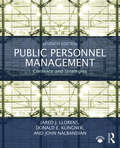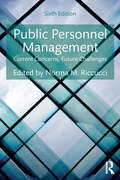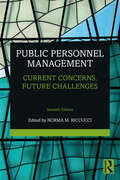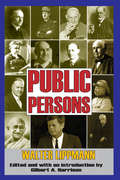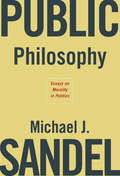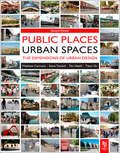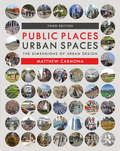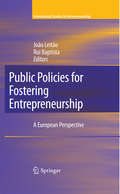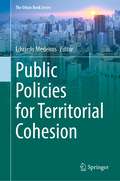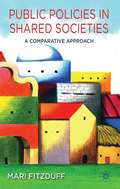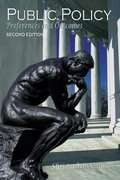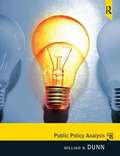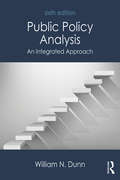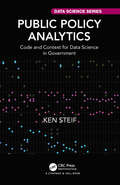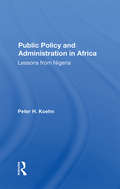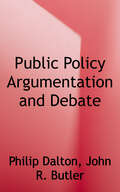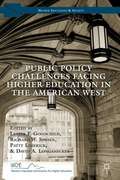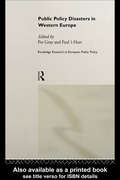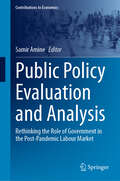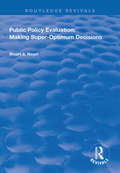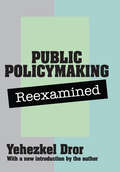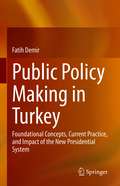- Table View
- List View
Public Personnel Management: Contexts and Strategies
by John Nalbandian Jared J. Llorens Donald E. KlingnerNow in a thoroughly revised 7th edition, Public Personnel Management focuses on the critical issues and common processes in the management of public sector personnel. In keeping with prior editions, the text centers on the core processes within public human resource management: strategic workforce planning, effective recruitment and retention, workforce development, and employee relations. Designed to further address the ways in which expectations for human resource managers have changed and developed in recent years, the 7th edition includes several new features and improvements: Substantially restructured, updated, and additional case studies and student exercises. Coverage of how the field of Public HRM has been influenced by the two most recent national recessions, economic downturns at the state and local level, privatization and contracting trends at all levels of government, the growing presence of millennial employees in the workplace, issues surrounding social media use within the workplace, the evolving goals of social equity and diversity, and the shifting role and influence of labor unions. Discussions of how the growth in information technology capabilities has influenced the major processes within HRM, from workforce analysis through big data analytics to the explosion in automated recruitment, assessment, and instructional technologies. For the first time, the text includes an online Instructor's Manual, PowerPoint slides, discussion questions, and suggestions for further reading to make it even easier to assign and use this classic text in the classroom. Providing the most up-to-date and thorough overview of the history and practice of public human resource management for both undergraduate and graduate students, Public Personnel Management, 7e remains the beloved text it ever was, ideal for introductory courses in Public Personnel Management, Public Human Resource Management, and Nonprofit Personnel Management.
Public Personnel Management: Current Concerns, Future Challenges
by Norma M. RiccucciPublic Personnel Management has served as an essential, concise reader for public personnel and human resource management courses in the fields of public administration, political science, and public policy over the last 25 years. Since the first edition published in 1991, the book has offered professors and students alike an in-depth look at cutting-edge developments beyond standard textbook coverage, to provide a broad understanding of the key management and policy issues facing public and nonprofit HRM today. Original chapters are written expressly for the text by leading public administration scholars, each focusing on specific and often controversial concerns for public personnel management, such as pensions, gender and sexuality, healthcare, unions, and a multi-generational workforce. Now in an extensively revised sixth edition, Public Personnel Management presents new, original chapters to examine developments of interest to researchers and practitioners alike, including: remote working, cybersecurity, public service motivation, the abandonment of traditional civil service at the state and local levels, the Affordable Care Act and its implications for practice, pension systems and labor relations, affirmative action, social equity, legislation surrounding LGBT rights, and – as the field of public personnel management becomes more internationalized – a chapter addressing public personnel management across Europe. This careful and thoughtful overhaul will ensure that Public Personnel Management remains a field-defining book for the next 25 years.
Public Personnel Management: Current Concerns, Future Challenges
by Norma M. RiccucciPublic Personnel Management has served as an essential, concise reader for public personnel and human resource management courses in the fields of public administration, political science, and public policy for more than 30 years. Since the first edition published in 1991, the book has provided professors and students alike with an in-depth look at cutting-edge developments beyond standard textbook coverage, to cultivate a broad understanding of the key management and policy issues facing public and nonprofit HRM today. Original chapters are written expressly for the text by leading public administration scholars, each focusing on specific and sometimes controversial concerns for public personnel management, such as social equity, labor relations, public employee rights, and the operation of nonprofits. Now in an extensively revised seventh edition, Public Personnel Management presents new, original chapters to examine developments of interest to researchers and practitioners alike, including: new ways of working (NWW), remote work, the effects of the COVID-19 pandemic on public service workforces, work-life balance, patterns of discrimination and employees’ perceptions of fairness, affirmative action, generational differences in the workforce, and – as the field of public personnel management becomes more internationalized – chapters addressing human resource management across Europe and a chapter NWW practices in Switzerland. These, together with other chapters, ensure that Public Personnel Management will remain a field-defining book for the next 30 years.
Public Persons
by Walter LippmannThis set of brief pieces examines the relation of power to knowledge. Lippmann paid little homage to the innate wisdom of the people. While he had no wish to disenfranchise citizens, he believed elites drove the engines of power. His point was that liberty and democracy require government that will, when necessary, "swim against the tides of private feelings." Because the public is too divided, poorly informed, and too self-regarding, authority has to be delegated, perhaps to "intelligence bureaus," or at least to those who are wiser than the many that have the power to decide vexing questions on their own merits.Lippmann knew that in the real world we cannot expect to be ruled by philosopher-kings. While ready to settle for less, he was not ready to settle for politicians who get ahead "only as they placate, appease, bribe, seduce, bamboozle and otherwise manage to manipulate demanding and threatening elements in their constituencies." The seducers and bamboozlers were generally in charge, and because they were in an age "rich with varied and generous passions" they had become disorderly and deranged.Public Persons is the informal side of The Public Philosophy. Lippmann tries to account for the decline of Western democracies and prescribe for their revival. He concludes that it is not possible to discover by rational inquiry the conditions that must be met if there is to be a good society. Lippmann saw tension between private impulses and transcendent truth as the "inexhaustible theme of human discourse." The occasional harmonies in the lives of saints and the deeds of heroes and the excellence of genius are glorious. But glory was the exception, wretchedness the rule. In this casual volume both are given a human face.
Public Philosophy: Essays on Morality in Politics
by Michael J. SandelIn this book, Michael Sandel takes up some of the hotly contested moral and political issues of our time, including affirmative action, assisted suicide, abortion, gay rights, stem cell research, the meaning of toleration and civility, the gap between rich and poor, the role of markets, and the place of religion in public life. He argues that the most prominent ideals in our political life--individual rights and freedom of choice--do not by themselves provide an adequate ethic for a democratic society. Sandel calls for a politics that gives greater emphasis to citizenship, community, and civic virtue, and that grapples more directly with questions of the good life. Liberals often worry that inviting moral and religious argument into the public sphere runs the risk of intolerance and coercion. These essays respond to that concern by showing that substantive moral discourse is not at odds with progressive public purposes, and that a pluralist society need not shrink from engaging the moral and religious convictions that its citizens bring to public life.
Public Places - Urban Spaces
by Steve Tiesdell Tim Heath Taner OcPublic Places Urban Spaces, 2e, is a thorough introduction to the principles of urban design theory and practice. Authored by experts in the fields of urban design and planning, it is designed specifically for the 2,500 postgraduate students on Urban Design courses in the UK, and 1,500 students on undergraduate courses in the same subject.The 2e of this tried and trusted textbook has been updated with relevant case studies to show students how principles have been put into practice. The book is now in full color and in a larger format, so students and lecturers get a much stronger visual package and easy-to-use layout, enabling them to more easily practically apply principles of urban design to their projects.Sustainability is the driving factor in urban regeneration and new urban development, and the new edition is focused on best sustainable design and practice. Public Places Urban Spaces is a must-have purchase for those on urban design courses and for professionals who want to update and refresh their knowledge.
Public Places Urban Spaces: The Dimensions of Urban Design
by Matthew CarmonaPublic Places Urban Spaces provides a comprehensive overview of the principles, theory and practices of urban design for those new to the subject and for those requiring a clear and systematic guide. In this new edition the book has been extensively revised and restructured. Carmona advances the idea of urban design as a continuous process of shaping places, fashioned in turn by shifting global, local and power contexts. At the heart of the book are eight key dimensions of urban design theory and practice—temporal, perceptual, morphological, visual, social, functional—and two new process dimensions—design governance and place production. This extensively updated and revised third edition is more international in its scope and coverage, incorporating new thinking on technological impact, climate change adaptation, strategies for urban decline, cultural and social diversity, place value, healthy cities and more, all illustrated with nearly 1,000 carefully chosen images. Public Places Urban Spaces is a classic urban design text, and everyone in the field should own a copy.
Public Policies for Fostering Entrepreneurship
by Rui Baptista João LeitãoThe contribution of this book is to join in the same volume a set of theoretical visions and empirical assessments by leading scholars about public policies towards entrepreneurship in Europe and how to rethink them. The book is divided in two parts: Part I - Entrepreneurship Policies - A European Framework; and Part II - Entrepreneurship Policy in Countries and Regions. In Part I various theoretical approaches are presented by prominent scholars from around the world. They point to the need for the European economy to be the subject of regional reorganization, based on concentrations of production activities with a strong component of knowledge and technology. This book appears at a particularly challenging time, in economic and social terms, when entrepreneurship and innovation assume particular strategic importance, inasmuch as endogenous growth should be considered by policy-makers and also by business-people and citizens as one of the driving forces that can catalyze regional economies. The Entrepreneurship Policy examples contained in Part II from European countries in Scandinavia, Iberia, Germany, Turkey and the UK explore the implications for research, practice and policy-making in those regions.
Public Policies for Territorial Cohesion (The Urban Book Series)
by Eduardo MedeirosThis book introduces a comprehensive and updated analysis of the role of public policies to promote territorial cohesion processes and trends in a given territory. By being the first book taking a reflective and holistic approach on how public policies can lead to more cohesive and balanced territories, it advances theoretical avenues for academics and showcases current academic research to policymakers and practitioners by focusing on how public policies, being implemented in different territorial scales (urban, local, regional, national, and European), can actively contribute to foster territorial cohesion trends in a given territory. This reflective approach provides an opportunity for thinking about what lessons can be learned from past and ongoing experiences and how they can improve future implementation of public policies more effectively and efficiently toward territorial cohesion, since all existing analyses show that at the national level, no European country has achieved territorial cohesion trends over the past decades. As such, this book acts as a valid and useful policy manual that effectively contributes to inverting current territorial exclusion trends at the national level, by highlighting best policy practices and a comprehensive introduction to contemporary thinking about how public policies can play a decisive role in boosting territorial cohesion processes in a given territory.
Public Policies in Shared Societies
by Mari FitzduffCommunities throughout the world are increasingly diverse in their racial, ethnic and religious make up. Using examples drawn from over 50 countries in a variety of fields from economics to education, this book explores how governmental, economic and social institutions are adapting their policies to create more cohesive and peaceful societies.
Public Policy
by Christopher SimonBuilt on the premise that all public policy is ultimately grounded in the philosophy of governance, Christopher A. Simon's second edition continues to approach policy by combining normative and empirical perspectives. This deeply revised second edition continues to expose students to the basis of preferences, policy-making processes, policy history, and current policy decisions and outcomes. Chapters conclude with a case studies engaging students in the application of their theoretical knowledge to the real world, and encouraging them to be informed and active citizens. Key Features: Alternate tables of content are included to provide professors and students with flexible, easy-to-implement options for approaching and assigning public policy. Case studies provide real-world examples that concretely illustrate theoretical concepts. End-of-Chapter questions reinforce key concepts and encourage students to think critically about the chapter topics. Each chapter ends with a two-part summary that offers a review of the major chapter concepts ("Lessons Learned") and puts them in context ("The Big Picture").
Public Policy Analysis
by William N DunnPublic Policy Analysis, the most widely cited book on the subject, provides readers with a comprehensive methodology of public policy analysis. Starting from the premise that policy analysis is an applied social science discipline designed for solving practical problems facing public and nonprofit organizations, the book bridges the gap between theory and practice. It provides practical skills for conducting policy analysis and communicating findings through memos, position papers, and other forms of structured analytical writing. The book asks readers to critically anazlye the arguments of policy practitioners as well as political scientists, economists, and political philosophers.
Public Policy Analysis (Fifth Edition)
by William N. DunnPublic Policy Analysis, the most widely cited book on the subject, provides readers with a comprehensive methodology of public policy analysis. Starting from the premise that policy analysis is an applied social science discipline designed for solving practical problems facing public and nonprofit organizations, the book bridges the gap between theory and practice. It provides practical skills for conducting policy analysis and communicating findings through memos, position papers, and other forms of structured analytical writing. The book asks readers to critically anazlye the arguments of policy practitioners as well as political scientists, economists, and political philosophers.
Public Policy Analysis: An Integrated Approach
by William N. DunnPublic Policy Analysis, the most widely cited book on the subject, provides students with a comprehensive methodology of policy analysis. It starts from the premise that policy analysis is an applied social science discipline designed for solving practical problems facing public and nonprofit organizations. This thoroughly revised sixth edition contains a number of important updates: Each chapter includes an all-new "big ideas" case study in policy analysis to stimulate student interest in timely and important problems. The dedicated chapter on evidence-based policy and the role of field experiments has been thoroughly rewritten and expanded. New sections on important developments in the field have been added, including using scientific evidence in public policymaking, systematic reviews, meta-analyses, and "big data." Data sets to apply analytical techniques are included online as IBM SPSS 23.0 files and are convertible to Excel, Stata, and R statistical software programs to suit a variety of course needs and teaching styles. All-new PowerPoint slides are included to make instructor preparation easier than ever before. Designed to prepare students from a variety of academic backgrounds to conduct policy analysis on their own, without requiring a background in microeconomics, Public Policy Analysis, Sixth Edition helps students develop the practical skills needed to communicate findings through memos, position papers, and other forms of structured analytical writing. The text engages students by challenging them to critically analyze the arguments of policy practitioners as well as political scientists, economists, and political philosophers.
Public Policy Analytics: Code and Context for Data Science in Government (Chapman & Hall/CRC Data Science Series)
by Ken SteifPublic Policy Analytics: Code & Context for Data Science in Government teaches readers how to address complex public policy problems with data and analytics using reproducible methods in R. Each of the eight chapters provides a detailed case study, showing readers: how to develop exploratory indicators; understand ‘spatial process’ and develop spatial analytics; how to develop ‘useful’ predictive analytics; how to convey these outputs to non-technical decision-makers through the medium of data visualization; and why, ultimately, data science and ‘Planning’ are one and the same. A graduate-level introduction to data science, this book will appeal to researchers and data scientists at the intersection of data analytics and public policy, as well as readers who wish to understand how algorithms will affect the future of government.
Public Policy And Administration In Africa: Lessons From Nigeria
by Peter KoehnOriginally published in 1990. A look at the vast, historically and socially complex nature of the Nigeria This book is intended to share what he has learned about public policy and administration in Africa over the past ten years. This book is based upon a decade of research, reflection, and writing. The field research period corresponds with the
Public Policy Argumentation and Debate: A Practical Guide for Advocacy
by Philip Dalton John R. ButlerThrough an exclusive focus on public policy advocacy as a practical endeavor, the authors Philip Dalton and John R. Butler depart from approaches to debate education that focus on the rules of simulated, academic debate formats. Beginning with the assumption that readers have already developed a basic capacity to argue, they offer practical guidance for determining the fundamental issues that make up a controversy and what expectations public audiences will have for advocacy based on the issues and the burdens of advocates challenging or defending the status quo. Through examples that span a wide range of advocacy situations and subjects of contemporary importance, the authors build a framework for public policy advocacy that is organic to the communication discipline, recover and refresh foundational lessons about the uses of evidence, and provide critical questions that can be used to develop and communicate policy proposals that are sensible and appealing. Written in an accessible, respectful, and motivational style, the book is suitable for students of debate, professionals who function as advocates, and people who find themselves wishing to voice their opinion on an issue of concern.
Public Policy Challenges Facing Higher Education In The American West
by Lester F. Goodchild Richard W. Jonsen Patty Limerick David A. LonganeckerPublic Policy Challenges Facing Higher Education in the American West is the first regional public policy study of American higher education. Presidents of the Western State Commission for Higher Education and the National Center for Higher Education Management Systems, alongside nationally recognized policy analysts and current western campus presidents, provosts, and administrators, tackle seven key public policy issues facing postsecondary education in the American West: student access, federal research funding, state governance, state financing, state appropriations and their relationship to institutional tuition, distance education and technology, and the role of community colleges. These analysts, researchers, and administrators offer a clear and complete analysis of the facts of each policy situation, the public policy options, and their connections to state and university relationships. Fifteen western states, including Alaska, California, and Hawaii, comprise the expansive region under discussion. With its companion volume, Higher Education in the American West: Regional History and State Contexts, this book is essential reading for higher education policymakers, scholars, and anyone who wants to know what the relationship between states and universities in the West has been and where it is going.
Public Policy Disasters in Europe (Routledge Research in European Public Policy)
by Pat Gray Paul’t HartThis book considers some recent and spectacular failures in policy-making and asks what is meant by policy 'disaster', the different forms that they can take and why they have occured. These issues are explored in nine contrasting cases drawn from both the European Union and its member states. These include: the devastating crisis in the Belgium political system following the exposure of a paedophile ring; the crisis in the Dutch fight against drugs; 'Mad Cows', the 'Arms to Iraq' affair in the UK; monetary union between West and East Germany; the Swedish monetary crisis of 1992; and the EU's common fisheries policy and policies towards civil war in Yugoslavia. This book is an excellent study of how and why policies can go wrong and highlights the limits of what governments can achieve in Western Europe.
Public Policy Evaluation and Analysis: Rethinking the Role of Government in the Post-Pandemic Labour Market (Contributions to Economics)
by Samir AmineThis edited volume examines how some OECD countries have adapted to new challenges in the labor market by evaluating and analyzing public programs implemented before, during, and after Covid-19. To gain a comprehensive understanding, the volume adopts a multidisciplinary approach, with chapters contributed by authors from diverse disciplines and academic and professional backgrounds.
Public Policy Evaluation in the Middle East and North Africa
by Anis Ben BrikThis book examines the progress of the development of public policy evaluation in the Middle East and North Africa (MENA) region from multiple perspectives. It describes both past developments and the current state of evaluation across the region, focusing on how political regimes, administrative traditions and policy advisory systems shape evaluation processes in different contexts. With contributions from a diverse list of international authors, it investigates the historical development of evaluation across the MENA region and analyses the political landscape, highlighting emerging trends and potential challenges that could influence the future of the field. An essential resource for researchers and practitioners in evaluation, public policy and the MENA region, the book also provides students with the practical knowledge and essential skills needed for careers in evaluation and policy analysis.
Public Policy Evaluation: Making Super-Optimum Decisions (Routledge Revivals)
by Stuart S. NagelFirst published in 1998, this volume examines how super-optimum decisions involve finding alternatives to controversies whereby Conservatives, Liberals, or other major groups can all come out ahead of their best initial expectations simultaneously. This book is organised in terms of concepts, methods, causes, process, substance, and the policy studies profession. Concepts clarify that policy evaluation traditionally involves: (1) Goals to be achieved; (2) Alternatives available for achieving them; (3) Relations between goals and alternatives; (4) Drawing a conclusion as to the best alternative in light of the goals, alternatives, and relations; and (5) Analysing how the conclusion would change if there were changes in the goals, alternatives, or relations. Super-optimizing also involves five related steps, but with the following improvements: (1) Goals are designed as conservative, liberal, or neutral; (2) Alternatives get the same designations; (3) Relations are simplified to indicate which alternatives are relatively high or low on each goal; (4) The conclusion involves arriving at an alternative that does better on Goal A than Alternative A, and simultaneously better on Goal B than Alternative B; and (5) The fifth step involves analysing the super-optimum or win-win alternative in terms of its feasibility as to the economic, technological, psychological, political, administrative, and legal matters.
Public Policy For Women
by Jane Pulkingham Marjorie Griffith CohenContaining essays from leading feminist academics, and social activists, Public Policy for Women addresses important public policy issues that fail to address women's needs. The volume's contributors pay particular attention to the relationship between the welfare state and vulnerable populations of women, while making substantial contributions to current public policy debates in Canada.Focusing on discussions of controversial issues such as single working mothers, prostitution, mandatory retirement, guaranteed income, and work for welfare, these essays also consider the political and economic constraints that have been brought about by neo-liberal policy changes. Full of relevant policy critiques and original recommendations for improvement, Public Policy for Women readdresses often neglected subjects and concerns and makes informative appeals for public policy to address women's needs.
Public Policy Making Reexamined
by Yehezkel DrorPublic Policymaking Reexamined is now recognized as a fundamental treatise for public policy studies. Although it caused much controversy when it was first published for its systematic approach to policy studies, the book is acknowledged as a modern classic of continuing importance for the teaching and research of public policy, planning and policy analysis, and public administration. The paperback includes a new introduction updating and supplementing many of the author's original ideas.Professor Dror combines the approaches of policy analysis, behavioral science, and systems analysis in his examination of the reality of public policymaking and his suggestions for its reform. Actual policymaking is carefully evaluated with the help of explicit criteria and standards based on an optimal model approach, resulting in detailed proposals for improvement. He applies a scientific orientation to the study of social facts and theory.
Public Policy Making in Turkey: Foundational Concepts, Current Practice, and Impact of the New Presidential System
by Fatih DemirThis volume discusses public policy making in Turkey. Using Turkey as an overarching case study, the author presents foundational concepts of public policy analysis. The method followed in the book is from general to specific: in each chapter, the relevant public policy stage or concept is explained and discussions from international literature are provided first. Then, Turkish cases are presented and clarified using theoretical concepts and debates. Additional examples from other municipalities are included for a comparative perspective. This volume will be of use to researchers and students studying public policy, policy analysis, and global public administration as well as professionals, policymakers, and diplomats working in the Turkish public sector.
